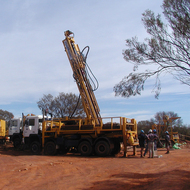Round 17 applicants cover a range of regions and commodities
| Date: | Tuesday, 29 May 2018 |
|---|
Round 17 of the Exploration Incentive Scheme’s (EIS) flagship co-funded drilling program has offered $5.2 million between 42 projects.
The popular drilling program aims to unearth Western Australia’s next wave of resource discoveries by focusing on innovative exploration in remote and underexplored greenfield regions.
Department of Mines, Industry Regulation and Safety (DMIRS) EIS Coordinator Charlotte Hall said Round 17 projects were in diverse locations ranging from the South West to the Gascoyne and Kimberley, and to near the State’s remote eastern border.
“The projects are targeting a mix of commodities including well-known metals such as copper, gold and base metals, as well as less common resources such as graphite, manganese and heavy rare earth elements,” she said.
“The co-funded drilling program always draws a lot of interest, which is partly due to its successful history.
“In the 10 years the scheme has been running, exploration teams have drilled more than 630,000 metres and made a number of major resource discoveries.”
Dr Hall said by encouraging companies to conduct innovative drilling programs, particularly in underexplored and greenfield areas, the program adds to the geological knowledge of the State, helps diminish risks for future explorers, and improves exploration efficiency.
The program will refund companies and prospectors up to 50 per cent of direct drilling costs – with caps of $150,000 for a multi-hole project, $200,000 for a single deep hole, and $30,000 for a prospector’s project.
The list of Round 17 successful applicants is available on the DMIRS website.
Each project must submit comprehensive reports with analytical data, which DMIRS releases publically on its WAMEX and WAPIMS databases after a six-month confidentiality period.
Round 18 of the application process will open in August-September 2018 for co-funded projects to be drilled in 2019.
In the recent State Budget, it was announced that the EIS scheme would continue in the long term and be funded from an increase in mining tenement rental to raise $10 million annually.

